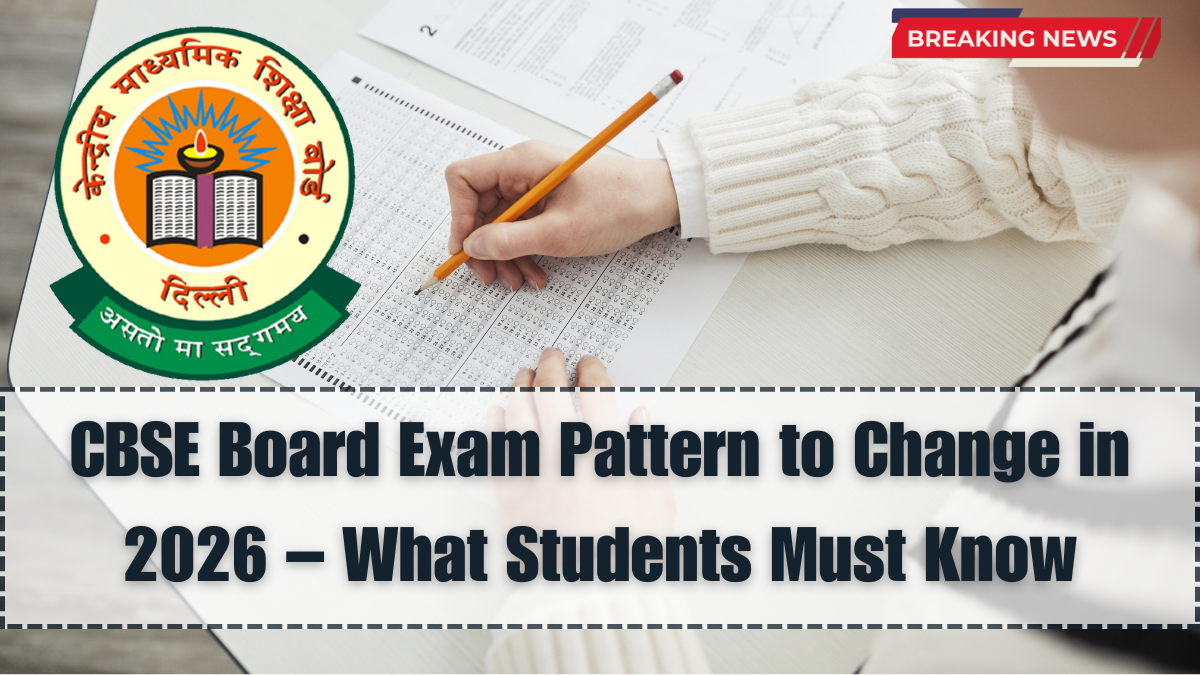The CBSE Board Exam Pattern Change 2026 has been officially confirmed, and all schools affiliated with the Central Board of Secondary Education (CBSE) are now preparing for the new structure. Starting with the academic year 2025–26, students appearing for Classes 10 and 12 board exams will face a restructured question paper model that focuses more on competency-based questions and real-life application of concepts.
This change is in line with the National Education Policy (NEP) 2020 and is aimed at reducing rote learning while promoting critical thinking. The CBSE Board Exam Pattern Change 2026 is already being implemented in model question papers and internal assessments across schools in India.

Key Features of the New Exam Pattern
The CBSE Board Exam Pattern Change 2026 introduces several major structural changes in how board exams will be conducted:
-
Competency-based questions to form at least 50% of the total paper
-
Reduced weightage of theoretical questions that require memorization
-
Increased focus on application, reasoning, and problem-solving
-
Greater inclusion of case-based and source-based questions
-
More internal assessment and project-based evaluation
These changes have already been circulated to schools through official CBSE circulars under the CBSE 2026 update.
Subject-Wise Marking Scheme – What’s Changing?
Here is a simplified breakdown of the revised marking structure under the CBSE Board Exam Pattern Change 2026:
| Question Type | Previous Weightage | New Weightage |
|---|---|---|
| Competency-Based Questions | 20% | 50% |
| Objective/MCQs | 20% | 20% |
| Short/Long Answer (Theory) | 60% | 30% |
The shift to competency-based questions is expected to create a more application-oriented and student-friendly assessment pattern.
Impact on Students and Teachers
With the CBSE Board Exam Pattern Change 2026, both students and educators are seeing a shift in classroom learning:
-
Teachers are now adopting activity-based learning methods
-
Students are encouraged to understand concepts deeply instead of memorizing
-
Internal assessments now include projects, presentations, and research tasks
-
Model question banks are provided to help students adapt
This approach ensures that learners are evaluated on skills that matter in real-world scenarios, not just memory-based answers.
Guidelines Issued by CBSE for 2026 Exams
To support this transformation, CBSE has issued new academic guidelines that are now in effect:
-
Schools must follow new sample papers available on the CBSE academic portal
-
Teachers must undergo orientation programs on exam pattern changes
-
Regular assessments will be monitored to match the new marking scheme
-
Classroom strategies must now align with competency-based learning
These guidelines are a part of the holistic development goal set under the CBSE 2026 vision.
FAQs
What is the CBSE Board Exam Pattern Change 2026?
CBSE Board Exam Pattern Change 2026 is a reform in CBSE’s assessment structure that increases the weightage of competency-based questions to 50% in Class 10 and 12 exams.
When will the new exam pattern be implemented?
The new pattern is applicable from the 2026 academic session and affects students appearing for the board exams in that year.
What are competency-based questions?
These are application-oriented questions that test students’ understanding, analysis, and problem-solving skills instead of rote memorization.
Will the syllabus change with this exam pattern?
The syllabus remains the same, but the exam pattern and marking scheme are modified to include more concept-based questions.
How should students prepare for the new pattern?
Students should focus on NCERT textbooks, practice sample papers based on CBSE 2026 guidelines, and participate in activities that enhance understanding and reasoning.
Click here to know more.
